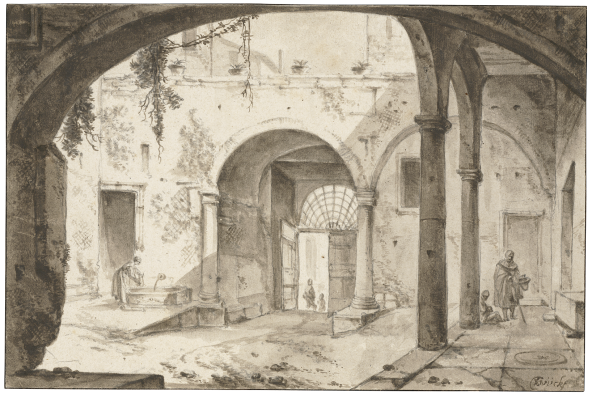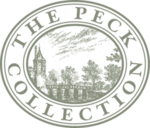Choose a background colour
Thomas Wyck, Dutch, 1616-1677
:
A Courtyard in Italy, c. 1640-50
Brush and gray ink with additions in pen and light brown ink (for the buildings in the distance) over traces of graphite on paper; framing lines in brown ink.
6 13⁄16 × 7 1⁄2 in. (17.3 × 19.1 cm)
Verso, lower left, in pen and ink, No 1473 (Jacob Helmolt’s inventory number, crossed out by Johann Goll van Franckenstein Jr.), lower left, N3998 (Johann Goll van Franckenstein’s inventory number), and lower left in pencil, 89.
- Chain Lines:
- Vertical, 25 – 26 mm.
- Watermark:
- Strasbourg Lily (cropped at top) with letters WR below. Similar to Heawood, no. 1730; and Ash & Fletcher 1998, variant G.c.
- Provenance:
Jacob Helmolt, Haarlem, 1747 – 1808 (Lugt 2986b, his inv. no. 1473 on verso); his sale, privately arranged, Amsterdam, 1808; Johann Goll van Franckenstein Jr., Amsterdam, 1750 – 1821 (Lugt 2987, his inv. no. N3998 on verso); Pieter Hendrik Goll van Franckenstein, Amsterdam, 1787 – 1832; his sale, De Vries et al., Amsterdam, 1 July 1833, lot D20 (sold for fl . 18.50 to Roos); W. van Dalfsen (not in Lugt, his monogram in purple ink stamped on recto, lower left, WVD); sale, Sotheby Mak van Waay, Amsterdam, 18 November 1985, lot 44; dealer, Thomas le Claire, Hamburg, 1989; sale, Sotheby’s, Amsterdam, 12 November 1991, lot 279; Sheldon and Leena Peck, Boston (Lugt 3847); gift to the Ackland Art Museum, inv. no. 2017.1.98.
- Literature/Exhibitions:
Beck 1993, 377, no. 1473; F. Robinson in Chapel Hill, Ithaca & Worcester 1999 – 2001, 114 – 15, no. 40.
- Ackland Catalogue:
- 2017.1.98
Thomas Wijck was a prominent artist based in Haarlem who entered the guild in 1642 and served in leadership positions several times over the course of his career, twice as dean. Aside from his many Italianate views, which he painted, drew, and etched, he is also known for his paintings depicting alchemists in their workshops executed in a completely different mode.1
In relation to Wijck’s Italianate subject matter, it is frequently stated that there is no secure, surviving evidence that he actually went to Italy.2
Arnold Houbraken (1660 – 1719), however, asserted that the artist drew many things from life there, and in Wijck’s case, we have enough indirect evidence to support the notion.3
He is entirely absent in the Haarlem archival records between 1644 (the year of his marriage) and 1653, leaving enough of a gap for an extended stay elsewhere. A few of his Italianate drawings also bear Italian watermarks.4
Furthermore, we know that Wijck was not averse to long-distance travel since in the 1660s he went to Britain, where his artist son, Jan, later settled.
A courtyard such as the one in the Peck drawing features as the primary subject matter in many of Wijck’s Italian-themed drawings.5
These fascinate for their prosaic nature, especially since they differ so greatly from the majestic buildings portrayed in the majority of works by artists who sojourned to Rome and elsewhere in Italy. While Wijck occasionally drew larger structures, he focused more frequently on less distinguished edifices, and on architecture that might be old and full of character yet otherwise nondescript. As such, Wijck is often grouped with the Bamboccianti, or followers of Pieter van Laer (1599 – c. 1642, nicknamed Bamboccio), a group of mostly Dutch and Flemish artists in Rome who focused on scenes of everyday life, and who enjoyed prestige and patronage both in Italy and back home. While Wijck cannot be definitively connected to Van Laer, we know that the latter was in Haarlem between 1639 and 1642, just as Wijck was likely completing his training there.6
In the present work, we see a muleteer with his barrels entering a yard through a great arch, behind which can be seen buildings in the distance. Though the exact site cannot be identified, the arrow slits above the arch indicate this structure is (or formerly was) the main wall of a city. The driver appears to be bidding farewell to his erstwhile traveling companion who continues on his way. Foreground detritus — barrels, planks, a cooking pan, and a broken basket — comprise precisely the sort of anticlimactic entry into a city after a long journey that lends the scene its quotidian charm. Wijck’s courtyard, or cortile, drawings are often set in an inn or tavern, or someplace more obviously domestic than in the present work. A signed sheet that bears comparison to the Peck drawing in the Teylers Museum is a good example Fig. 26.1.7

Thomas Wijck, An Italian Courtyard, c. 1636 – 77. Graphite, brush and brown wash, 154 × 232 mm. Haarlem, Teylers Museum, inv. no. p*11.
Teylers Museum, Haarlem, The Netherlands
Its perspectival construction likewise revolves around an arched entrance in the middle ground, and it displays stylistically similar scrubby foliage emerging from the walls and stones. Wijck made many of his drawings primarily in wash, using a remarkably controlled fine-pointed brush for details such as the figures and animals, and generating delicate lighting effects in the more broadly toned areas. He would sometimes touch up details with a pen, just as he does in the present work, to limn the distant buildings. Several of his courtyard drawings exist in multiple versions, not as strict replicas but rather showing the same courtyard with slight differences in detail and architectural arrangement.8
Like other artists, Wijck must have returned home with a stock of drawings that he could use to create other works for the collectors’ market.9
The present drawing is on a sheet of paper with a Northern watermark and may be such a work. No related sheets showing the same or similar courtyard have come to light, and it is possible that Wijck invented the scene entirely.
End Notes
For Wijck’s Italianate drawings, see Steland 1987 – 88; and P. Schatborn in Amsterdam 2001, 117 – 23; and for his Italian period in general, see L. Trezzani in Briganti et al. 1983, 222 – 37. For his alchemist paintings, see Drago 2019. See also, for his early career, Schnackenburg 1992.
For an overview of the evidence, see the biographies of the artist by I. van Thiel-Stroman in Biesboer et al. 2006, 347 – 51; and L. Trezzani in Turner 1996.
Houbraken 1718 – 21, vol. 2, 16 – 17 (“door hem zelf in Italien naar ‘t leven afgeteekent”).
P. Schatborn in Amsterdam 2001, 117, 119.
For these courtyard scenes generally, see P. Schatborn in Amsterdam 2001, 117 – 23. One of Wijck’s courtyards was also depicted by at least two other artists, suggesting that it was a known inn or stopping place in Italy among traveling Dutch artists (and further evidence that Wijck drew from life in Italy), for which see, idem, 16 – 17.
For Van Laer and the Bamboccianti, see Briganti et al. 1983; Levine 1986; Jansen & Luijten 1988; and Cologne & Utrecht 1991 – 92.
Plomp 1997, 473, no. 566.
For Wijck’s autograph repetition drawings, see especially P. Schatborn in Amsterdam 2001. See also Burke 1972; and the pair in the Fodor Collection (Amsterdam Museum) and Teylers Museum: Broos & Schapelhouman 1993, no. 185; and Plomp 1997, no. 566.
Furthermore, only a few of his Italianate drawings were apparently used as preparatory material for his paintings; see Van Suylen 2020, 203.
